California Dry Farm Trial Report 2022 - Organic Seed Alliance
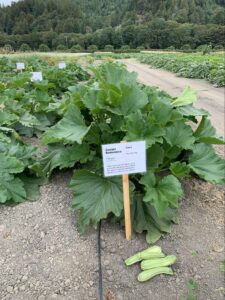
Publication Date: April 4, 2023
Authors: Jasmine Sarp and Jared Zystro, Organic Seed Alliance; Steve Peters, Seed rEvolution Now
Funder: Ida and Robert Gordon Family Foundation
Table of Contents
Introduction
Organic seed producers face many challenges related to production and field management. A 2021 survey of 127 organic seed producers and seed companies revealed that 77% of respondents find estimating adequate seed yields to be a challenge1. Survey participants suggested ideas to fill this knowledge gap, including the creation of a database of expected yield ranges, and regional data gathering on crops and specific varieties. An additional challenge indicated by the survey is adapting to climate change, with 71% of respondents reporting this as a difficulty. One example of how climate change has affected seed growers is limited access to irrigation due to drought conditions, and producers point to there not being “enough people doing drought- and heat-tolerant work.” Hence, a fundamental question to be asked is “How much loss of seed yield (if any) will occur under limited water or dry farm conditions?” This project was shaped by the above challenges and needs.
This trial was conducted to evaluate the seed yield and performance of several varieties of tomatoes, beans, and squash under organic cultivation with watering conditions ranging from dry-farmed to weekly irrigation. The trial focused on varieties that are known to produce a reasonable fresh market crop with limited water. What is less well known is how seed yields are affected by the same limited moisture regimes. Performance was measured through seed yield, seed germination rate, marketable fruit yield, and taste. Soil moisture readings were also taken throughout the duration of the trial to shed light on the varying conditions in which the plants grew, and in what conditions growers might achieve similar results. This trial was funded by the Ida and Robert Gordon Family Foundation.
What is dry farming?
Dry farming is a method of crop production practiced during a dry season. It does not use irrigation, but instead utilizes moisture stored in the soil from the preceding rainy season. Dry farming is usually practiced in regions that receive somewhere between 10 to 30 inches of annual rainfall. Success typically depends on utilizing moisture-conserving practices such as cultivation of a dust mulch layer, controlled weeding, and selection of drought resistant crops. Dry farming has been practiced across the world for thousands of years and today is an area of growing focus due to increasing water scarcity. To learn more, including seed varieties suitable for dry farming as well as a directory of Northwest US growers utilizing dry farm practices, visit the Dry Farming Institute online at dryfarming.org.
Materials and Methods
The trial was conducted at two sites in California. The first site was at the College of the Redwoods’ Sustainable Agriculture Farm in Shively, Humboldt County, California. The site is certified organic. The soil series where the trial was grown is a Shivelyflat silt loam, with a previous crop of brassicas, with no supplemental fertilizer applied. The Shively area is known for dry farm agricultural production, due in part to its deep silty soils and its close proximity to the Eel River, which provides some sub-surface irrigation through underground water flow. The mean rainfall for Shively Flat is about 400 mm annually. Temperatures reach an average high of 78℉ at the height of summer, and an average low of 42℉ in winter.
A smaller trial was conducted on a certified organic field near the coastal town of Pescadero, California. The soil series, a Watsonville Silt Loam, is a deep, somewhat poorly drained alluvial soil. Mean annual rainfall, almost all coming between November and April, is about 500 mm. The summers are dry and cool, with daytime highs between 55-70℉, a significant amount of daytime fog, and also many sunny, windy days.

| Crop | Variety | Source | Description of fruits |
|---|---|---|---|
| Tomato | Atta Girl | Seed rEvolution Now | Red, medium globe-type |
| Tomato | Ruby Red | Seed rEvolution Now | Red-pink, medium globe-type |
| Tomato | Early Girl | Park Seed | Red, medium globe-type |
| Squash | Dark Star | Seed rEvolution Now | Dark green, glossy, large faceted shape |
| Squash | Goldini II | Fertile Valley | Golden-yellow, ridged, large shape |
| Squash | Costata Romanesco | High Mowing | Gray-green, prominent ribbing, small shape |
| Bean | UC Tiger’s Eye | Seed rEvolution Now | Yellow with red-purple stripes |
| Bean | UC Rio Zape | Seed rEvolution Now | Purple with dark crescent-shaped stripes |
| Bean | UC Southwest Red | Seed rEvolution Now | Red and white mottled pattern |
Variety Backgrounds
Atta Girl is a determinate, medium-sized red globe-type open pollinated tomato. It was developed by Seed rEvolution Now in Pescadero, California. All Seed rEvolution Now varieties have been bred for improved marketable yields, a lower cost of production and having outstanding flavor. All varieties are also open pollinated and in the public domain. Atta Girl is a cross of a BHN variety and a Canadian beefsteak hybrid.
Ruby Red is a determinate, medium to large-sized, red globe-type open pollinated tomato. It was developed by Seed rEvolution Now in Pescadero, California. Rutgers is a parent of this variety, which was bred by Lyman Schermerhorn in 1934. Rutgers is an indeterminate, somewhat disease resistant variety that was bred by crossing Marglobe and JTD (a tomato named after John Thompson Dorrance). The other parent is a determinate red, round beefsteak of unknown origin.
The Early Girl tomato variety is an early-ripening medium-sized red globe-type F1 hybrid. The hybrid was first developed in France. Joe Howland, chairman of Pan American Seed Company and board member of Petoseed Company, was in search of a short-season, cold-tolerant tomato, and learned of the variety in 1974. The two companies made some slight improvements and patented the variety as “Early Girl” to complement Burpee’s “Best Boy” variety. Petoseed was acquired by Seminis in 1995, and Seminis, in turn, was acquired by Monsanto in 2005. The patent has since expired. Early Girl is an indeterminate variety that is known for its fast and prolific growth, as well as its resilience under limited water conditions. Given the variety’s drought resistance, it is a top choice in dry farm tomato varieties. Attempts to de-hybridize the variety are ongoing, resulting in varieties like “Dirty Girl” from Joe Schirmer.
Dark Star is a prolific, drought resistant, bush-type dark green zucchini. Dark Star was developed by Bill Reynolds of Eel River Produce in Shively, California with support from Steve Peters, and plant breeder Dr. John Navazio (formerly with OSA). Reynolds started by dry farming two varieties of squash at his farm on the Eel River floodplain: the hybrid “Raven” and the heirloom “Black Beauty.” He crossed these plants, then selected from those, evolving a population with desirable traits for four years. He called this variety “Black Eel,” which was offered for sale through Seeds of Change. Further years of selection under organic, dry farming conditions brought a yet evolved population to be known as a new variety, “Dark Star.” Traits selected for include plant resiliency, longer season, continued production of male flowers throughout the season, short stocky plant stature, less spines, less cucumber mosaic virus/powdery mildew, longer shelf life, and more variable traits than F1s but higher yielding. Fruits are slightly sweet, and some bear a star shape on the flower end. Reynolds, an avid Grateful Dead fan, named the variety “Dark Star” after a song from the band’s 1969 album Live/Dead. Reynolds’ daughter, Rosie, and son, Jon, carry on their late father’s legacy by continuing to grow the seed on the family farm, and the variety continues to gain popularity among large and small scale farmers, including dry farmers, across the US.
Goldini II is a fast-growing summer squash bearing plentiful, shiny gold fruits with ridges. Goldini II was bred by Carol Deppe of Fertile Valley Seeds in Corvallis, Washington. This variety replaces her prior breed, Goldini I, now with improved mildew resistance and more consistent gold color compared to its earlier version. Bred under organic conditions, the parents of Goldini were Gold Rush (a hybrid from Seminis), and Costata Romanesco (the Italian heirloom). The resulting breed is a prolific plant with fruits that can be eaten raw, cooked, or dried, and fruits that are prime at larger sizes of 1-2 lbs. Some fruits have gold stems and tips, and others have green stems and tips, and plants also display a range of color in leaves, an intentional breeding choice favoring genetic heterogeneity, while prioritizing flavor and vigor. The plant tends to be resistant to powdery mildew if kept picked. At 35 days to maturity, Carol claims it is “possibly the fastest germinating and growing and most productive summer squash on the planet.” It is an Open Source Seed Initiative pledged variety.
Costata Romanesco is a classic striped heirloom summer squash, believed to have originated in Rome, Italy. It is considered a cocozelle squash, meaning that it has tender, dark green skin with light green stripes lengthwise, white to light-green flesh, and ribs. These types are known to have grown in Italy as long ago as the Renaissance. Costata Romanesco is sometimes called Ribbed Roman, a direct translation from the Italian name. Its habit varies from bush-type to vining and it thrives in warm weather. In addition to its lightly sweet, nutty-flavored and firm textured fruits, this variety is also known for producing many edible orange blossoms which can be harvested separately, or with young fruits. Fruits can be enjoyed raw or cooked, and flowers have many uses but in the surrounding mediterranean region, they have traditionally been stuffed then baked or deep fried. This variety can be susceptible to powdery mildew after the first few weeks of harvest, and is said to have lower productivity than some other squash varieties, but is worth growing for its excellent flavor.
UC Tiger’s Eye is a common bush bean variety with beans that are yellow in color with red-purple stripes. It was bred through the Student Collaborative Organic Plant Breeding Education (SCOPE) project at UC Davis. The variety was developed by recurrent backcrossing of the heirloom Tiger’s Eye (recurrent parent) and UC Canario 707 (donor parent), in an effort to create a variety similar to Tiger’s Eye that has improved yield and resistance to bean common mosaic virus. Tiger’s Eye is an heirloom from South America that is likely the same as a variety known as Pepa de Zapallo, which was collected in Chile in 1962. This variety, as well as UC Canario 707, possess genes that indicate that their origin is Andean. The resulting cross is similar to the recurrent parent- beans are also yellow in color with reddish purple stripes, tender-skinned and have similar flavor and texture. Multiyear, multi-location trials under organic conditions showed that the new variety yields 28% higher than the original Tiger’s Eye, and is indeed resistant to bean common mosaic virus.
UC Rio Zape is a dry pinto-type bean that is purple in color with dark crescent-shaped striping. It was also bred through the SCOPE project at UC Davis. The variety was bred by recurrent backcrossing between Rio Zape (recurrent parent) and ‘Matterhorn’ great northern bean (donor parent), in an effort to create a variety similar to Rio Zape with improved yield and resistance to bean common mosaic virus. Rio Zape is an heirloom that was uncovered in the Ancestral Pueblo cliff dwellings of the Zuni Pueblo in New Mexico in 1935. The flavor of this heirloom inspired the creation of the now-popular heirloom bean company, Rancho Gordo. Following the 1935 recognition, surrounding farmers readopted the bean under traditional dry farm methods and it became known as the Hopi Purple String Bean, or Mawiwjwa. In 1962 a sealed cave near the Rio Zape in Durango, Mexico was discovered, containing human remains along with several varieties of beans, corn, cucurbits, and other plant material. One of the bean varieties appeared to be the same as that discovered in the Zuni Pueblo. The UC-bred version is similar to this heirloom (to which it owes 98% of its original ancestry) in appearance, flavor and texture. Multiyear, multi-location trials under organic conditions showed that the new variety yields 19% higher than heirloom parent, and is indeed resistant to bean common mosaic virus.
UC Southwest Red is an heirloom-type bean with a red and white mottled pattern. It was also bred through the SCOPE project at UC Davis. The variety was bred by cross pollinating the heirloom Zuni Gold with a pink bean variety, UCD 9634. The goal was to breed a bean with the visual and culinary qualities of heirloom cultivars, resistance to bean common mosaic virus, and the season length and yield of modern cultivars. Zuni Gold is a mottled golden bean named for the Zuni peoples, and is also known as Four Corners Gold in reference to the bean’s origin on Zuni ancestral lands. This bean was traditionally honored in ceremonial dances, planted as one of the “three sisters” together with corn and squash, and is recognized today in Slow Food’s Ark of Taste. UCD 9634 is a pink bean that can typically be harvested 89 days after planting. UC Southwest Red is darker and more similar in appearance to a different heirloom, Anasazi. Multiyear, multi-location trials under organic conditions showed that in comparison to Anasazi, the new variety yields 53% higher, has earlier maturity, and is indeed resistant to bean common mosaic virus.
Trial design
The three trials (tomato, dry beans, and squash) were each designed as a complete block split-plot design with 3 replications in Shively (see Table 2). Whole plots were the three irrigation treatments (see irrigation treatment details below), and sub-plots were the three varieties. The irrigation treatments were not randomized; instead they were set up so that high and low treatments were separated from each other to minimize water travel from the high to low irrigation plots.
The bean varieties were direct-seeded in two 10’ rows per plot at 4” in-row spacing and 16” between-row spacing. Tomato plants were planted from starts in single 15’ rows per plot at 3’ in-row spacing and 6’ between-row spacing. Squash plants were direct-seeded in single 15’ rows per plot at 3’ in-row spacing and 6’ between-row spacing. The trials were planted on June 10th, 2022.
| Repetition | Rep 1 | Rep 1 | Rep 1 | Rep 2 | Rep 2 | Rep 2 | Rep 3 | Rep 3 | Rep 3 |
|---|---|---|---|---|---|---|---|---|---|
| Irrigation | Low | Med | High | High | Med | Low | Low | Med | High |
| Crop | Squash | Squash | Squash | Squash | Squash | Squash | Squash | Squash | Squash |
| Crop | Beans | Beans | Beans | Beans | Beans | Beans | Beans | Beans | Beans |
| Crop | Tomatoes | Tomatoes | Tomatoes | Tomatoes | Tomatoes | Tomatoes | Tomatoes | Tomatoes | Tomatoes |
Table 2. Field arrangement noting plot repetitions and irrigation treatment
Irrigation methods
The three irrigation treatments were:
- “Low” or dry farmed: these plots received no supplemental irrigation
- “Med”: these plots received 2 hours of drip irrigation every 4 weeks throughout the growing season. Irrigation was provided to each plot via a single line of pressure compensating drip irrigation at a flow rate of 40 GPH per 100 feet.
- “High”: these plots received 2 hours of drip irrigation every week throughout the growing season. Irrigation was provided to each plot via a single line of pressure compensating drip irrigation at a flow rate of 40 GPH per 100 feet.
Data collection methods
Available soil moisture was monitored on a weekly basis throughout the trial. PVC pipes were installed in the field with Watermark moisture sensors that extend underground to depths of 1ft, 2ft, 3ft, and 4ft. A set containing one sensor for each depth level was placed on a different row to measure the trial’s given water conditions: low, medium, and high. The sensors function by allowing for water in the soil to exchange with the device, providing a measurement of centibars (or kPa) of soil water tension. This measurement approach measures how much effort is required for a plant to draw in water that is available from the soil, not just the moisture percentage.
Marketable yield was also recorded on two plants per plot throughout the duration of the trial for tomatoes and squash.
For tomatoes, one plant per plot was designated for measuring seed yield as fruits ripened. For squash, one plant per plot was designated for measuring seed yield, and those fruits were left to grow over the course of the season and cure before processing.
For beans, plants were allowed to fully dry down before final harvest and weight was then obtained for seed yield/marketable yield.
Data analysis
Harvest counts, seed quantities, and seed germination rates were analyzed using in RStudio using the emmeans package and based on the linear model Trait ~ Variety + Irrigation + Variety*Irrigation + Replication, where Variety and Irrigation are fixed effects and Replication is a random effect. Stand Count was included as a covariate in the model for dry bean yields.
Results and Discussion
Water measurements
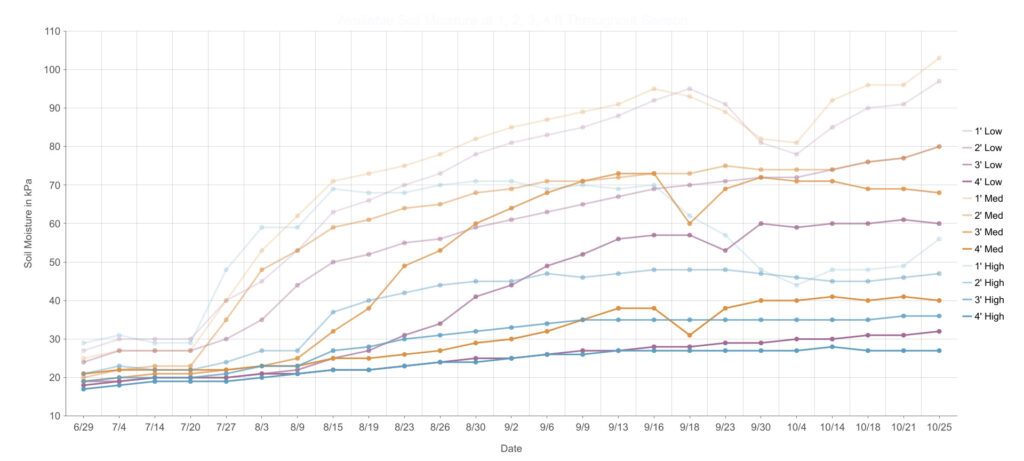
Shively water readings for all treatments (low, medium, and high water) showed moderate available water at all depths until mid-late July, with kPa remaining between 17 and 30. As the season progressed, water availability in upper depths was the first to decrease significantly. Sensors at 1 ft and 2 ft reached 60-85 kpi in August, meaning plant roots at this depth had to work 2-3x harder to absorb water than the month prior. Water readings across all depths began to reflect variation in water availability in September as a result of irrigation treatments, with the most significant fluctuation in the high water treatment read at a depth of 1 ft. By the end of the season, available water ranged from 27 to 103 kPa.
Tomatoes
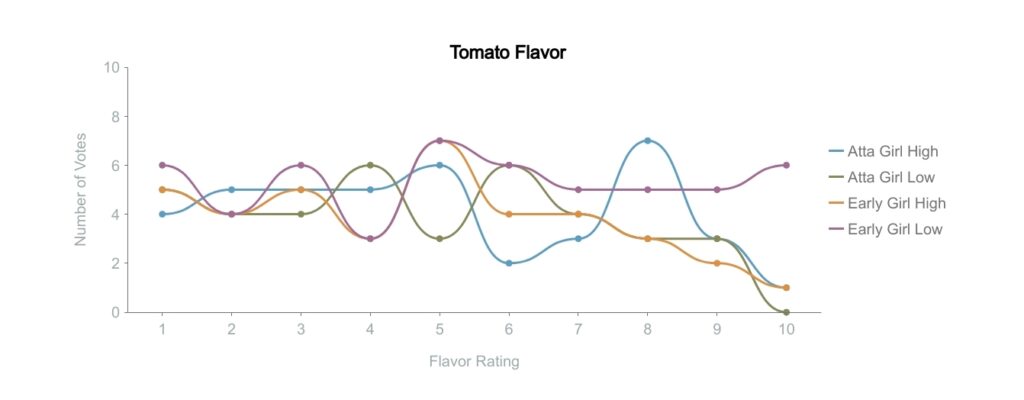
In an informal taste test conducted at a field day event with around 50 participants, there were not significant differences in flavor between dry farmed and irrigated tomatoes (see Figure 2). Participants were asked to rate flavor on a scale of 1-10, with 1 being the least desirable, and 10 being the best flavor. While votes varied greatly, there may have been a slight favor for Early Girl grown under dry farm conditions. These mixed results are a bit unexpected considering conventional wisdom that points to more intense, concentrated flavors in dry farmed produce. This could be because the area experienced a late, wet spring in 2022, and the moisture stress was still relatively low for dry farmed tomatoes when the taste test was held in early September. This could also be because of a wide range of preferences from tasters.
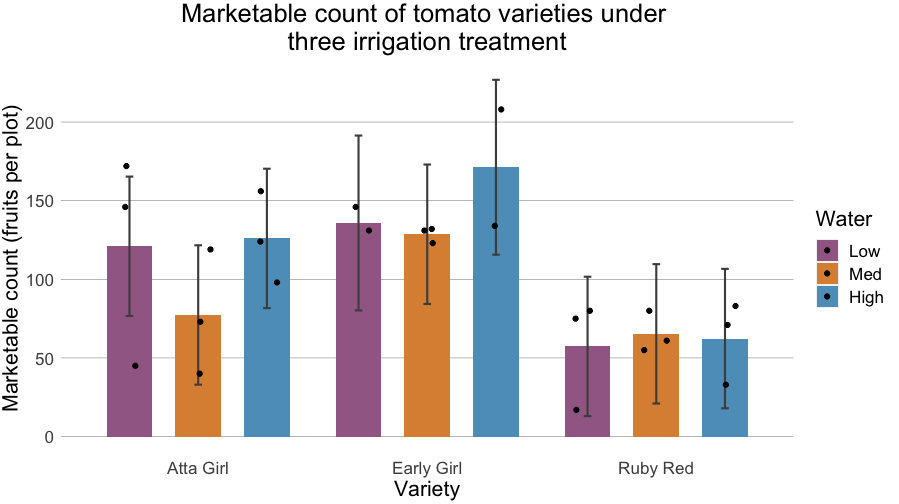
Figure 5. Marketable Tomato Yield. Colored bar represents averages across three replications each for low (dry farm), med, and high irrigation treatments. Error bars represent 95% confidence intervals. Points represent values for individual plots.
Marketable yield in tomatoes showed the most noticeable differences between varieties rather than irrigation regimens. Ruby Red stood out with a yield lower than Atta Girl and Early Girl, which is likely due to the late maturity of this variety. Early Girl showed a clear increase under high irrigation with nearly 175 fruits per plot, however, medium irrigation yielded slightly lower than the low irrigation treatment for this variety. It is also important to note that marketable tomato yield in this trial likely reflects more error than usual due to crow predation on the tomato plots.
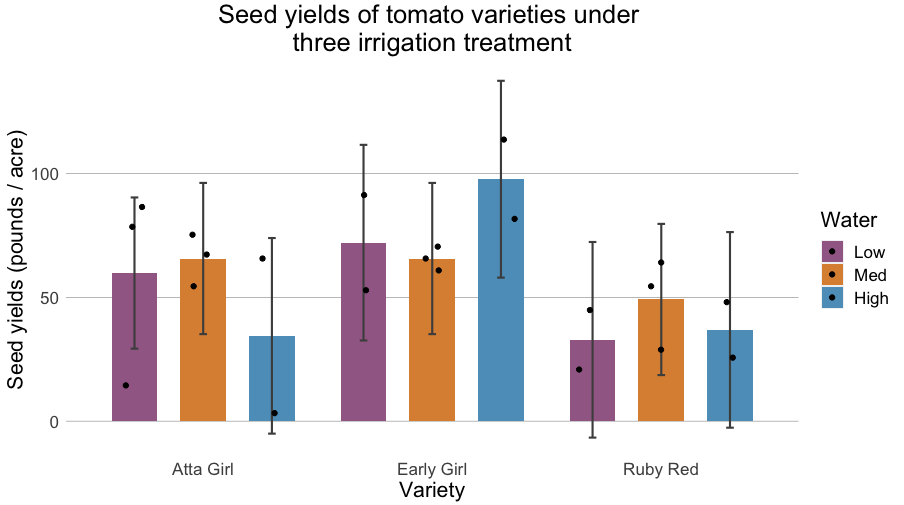
Seed yield in tomatoes tells a similar story as marketable yield. Ruby Red had a lower yield than other varieties, mirroring marketable fruit data, which is likely lower due to late maturity. While Early Girl showed higher yields for low and high irrigation, the data overall shows a lot of variation. Again, given the crow predation on these plots, this data may reflect a higher level of error than usual. Atta Girl appeared to have nearly equal performance, namely fruit count and seed yield, as Early Girl in low and medium water levels. The question for Atta Girl is: Why were seed yields so low at the high water levels?
Squash
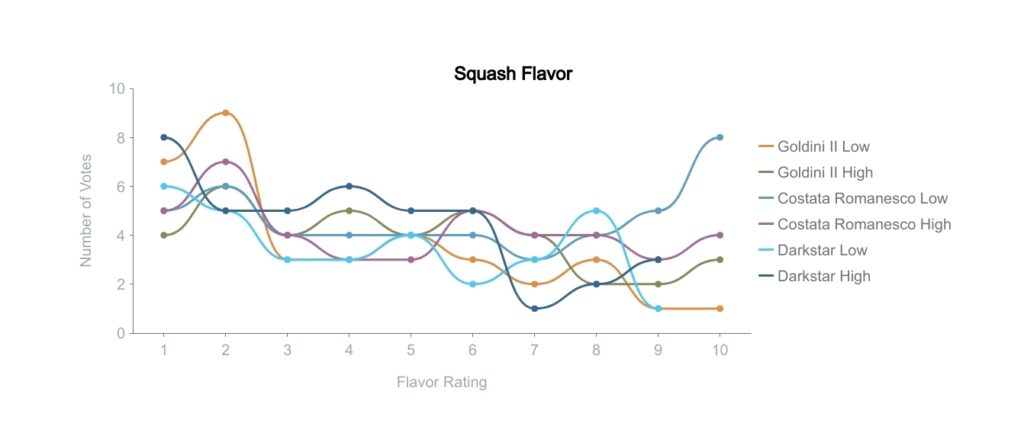
At the same informal taste testing event mentioned above, participants also sampled the three trialed squash varieties, under low and high irrigation treatments. Squash was prepared by steaming with a small amount of salt. As with tomato flavor, ratings varied widely, but Costata Romanesco under low irrigation received the most ratings of 10.

All squash varieties responded to irrigation with higher marketable yields in irrigated conditions vs. dry farm conditions. Costata Romanesco and Dark Star showed a direct correlation in yield from low to high irrigation, while Goldini II showed the highest yield under the medium irrigation treatment.


Squash seed yield showed differing results across varieties. Costata Romanesco and Dark Star both had fairly stable yields regardless of irrigation. These two varieties also had greater seed yield when compared with Goldini II. Goldini II seed yield was more sensitive to irrigation, and showed a direct correlation in yield to its watering treatment. Squash seed germination rates did not show a difference based on yield or variety type.
Dry Beans


All varieties of dry beans showed consistently better yields under increased irrigation. Rio Zape had the highest yield, followed by Southwest Red, and then Tiger’s Eye. Varieties showed about 30% increased yield under medium water conditions, and about 70% higher yield under high water conditions. Bean germination was better in Tiger’s Eye compared to the other varieties. Across all varieties, irrigation treatment did not impact germination rate.
Pescadero Site



The additional trial site led by Steve Peters in Pescadero explored squash and bean yield using similar variables. Figures 12-14 show a comparison of irrigated yield (number of squash fruits, and lbs of beans) as a percentage of dry farm yield in a few of the trialed varieties at both sites. Goldini II responded much more extremely to watering in Pescadero, with yield under medium and high irrigation treatments reaching around 700% of low irrigation treatment yield. This drastic increase in yield on the Pescadero site is likely because baseline soil conditions were drier there than in Shively. Dark Star in Pescadero also responded to the medium and high irrigation treatments, but not as drastically as Goldini II. Yield as percent of dry farm yield for Dark Star was more similar to that of Shively, with yield under high irrigation at both sites around 200%. The UC Tiger’s Eye bean variety was also trialed in Pescadero, and irrigated yield there looked different from Shively as well. Yield under high irrigation approached 300% of dry farm yield, as opposed to Shively’s which approached 200%. The higher water stress in Pescadero is likely why we see more extreme differences between the dry farm and irrigated treatments for the Dark Star, Goldini II, and UC Tiger’s Eye seed crops.
Given the variation in yield under the different water treatments and sites, seed farmers attempting production under limited irrigation conditions should be prepared to assess available moisture and consider adding at least some water if an optimal yield is desired. This is particularly true with dry beans and Goldini II squash, and perhaps less so with tomatoes. It is also worth noting the importance of site selection for dry farming, and how widely results can vary from site to site. Shively has been described by some as an optimal site for dry farming, and the trial season was a particularly mild one. The Pescadero site revealed greater variation. When looking at potential sites and conditions, a good question to ask might be, for dry farming, how dry is too dry?
Next Steps
This trial will be repeated in 2023 at the same site in Shively, California. All trial variables will remain the same except for one variety substitution: the tomato variety Dirty Girl will replace Ruby Red.
Given the challenges farmers face by increasing extreme high temperatures, an additional trial is being developed for 2023 to study how shade cloth could affect tomato pollination and fruit set. This trial will be carried out at a few different farm sites in the Western U.S. that experience high summer temperatures.
Footnotes
- Hubbard, Kristina (Kiki), Jared Zystro, and Liza Wood, State of Organic Seed (Port Townsend, WA: Organic Seed Alliance, 2022).
Citation: Sarp, J., Zystro, J. and Peters, S. 2023. California Dry Farm Trial Report 2022. Organic Seed Alliance, Port Townsend, WA.
Copyright 2023 Organic Seed Alliance
Educational Materials: This report is protected under a Creative Commons license: Attribution, Non-Commercial, and Share Alike. We believe in protecting intellectual property (IP) in a manner that promotes creativity and innovation in the interest of the public good. We encourage you to learn more about the Creative Commons, the open source movement, and other alternative IP models.
Organic Seed Alliance is the license holder of this proceedings. You are free to share (to copy, distribute, and transmit the work) and remix (to adapt the work) under these conditions:
- Attribution: You must attribute the work in the manner specified by the author or licensor (but not in any way that suggests they endorse you or your use of the work).
- Noncommercial: You may not use this work for commercial purposes.
- Share Alike: If you alter, transform, or build upon this work, you may distribute the resulting work only under the same or similar license to this one.
For any reuse or distribution, you must make clear to others the license terms of this work. The best way to do this is with a link to the Creative Commons web page: creativecommons.org. Any of the above conditions can be waived if you get permission from the copyright holder. Nothing in this license impairs or restricts the author’s moral rights. Your fair use and other rights are in no way affected by the above.
For PDF versions of this and other seed publications, please visit OSA’s Resource Library

